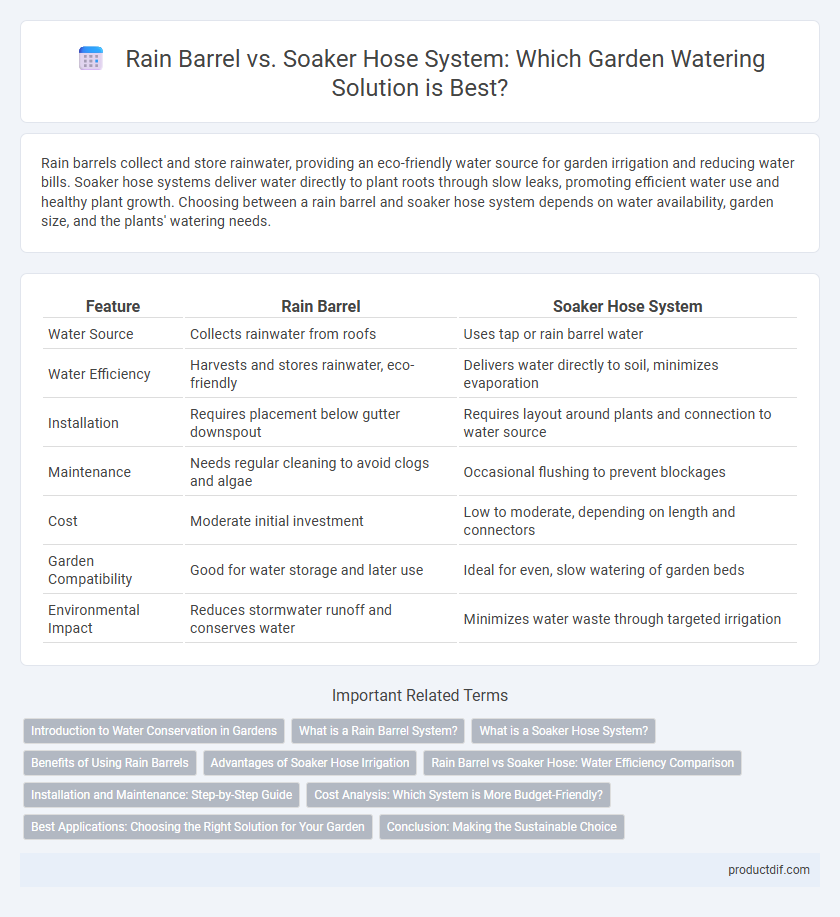Rain barrels collect and store rainwater, providing an eco-friendly water source for garden irrigation and reducing water bills. Soaker hose systems deliver water directly to plant roots through slow leaks, promoting efficient water use and healthy plant growth. Choosing between a rain barrel and soaker hose system depends on water availability, garden size, and the plants' watering needs.
Table of Comparison
| Feature | Rain Barrel | Soaker Hose System |
|---|---|---|
| Water Source | Collects rainwater from roofs | Uses tap or rain barrel water |
| Water Efficiency | Harvests and stores rainwater, eco-friendly | Delivers water directly to soil, minimizes evaporation |
| Installation | Requires placement below gutter downspout | Requires layout around plants and connection to water source |
| Maintenance | Needs regular cleaning to avoid clogs and algae | Occasional flushing to prevent blockages |
| Cost | Moderate initial investment | Low to moderate, depending on length and connectors |
| Garden Compatibility | Good for water storage and later use | Ideal for even, slow watering of garden beds |
| Environmental Impact | Reduces stormwater runoff and conserves water | Minimizes water waste through targeted irrigation |
Introduction to Water Conservation in Gardens
Rain barrels capture and store rainwater, providing an eco-friendly water source that reduces reliance on municipal supply for garden irrigation. Soaker hose systems deliver water directly to plant roots through porous tubing, minimizing evaporation and runoff while maximizing soil absorption. Combining rain barrels with soaker hoses enhances overall water conservation by utilizing harvested rainwater efficiently in garden watering routines.
What is a Rain Barrel System?
A rain barrel system collects and stores rainwater from rooftops through downspouts, providing an eco-friendly irrigation source for gardens. It reduces reliance on municipal water, conserves water during dry periods, and helps prevent stormwater runoff that can cause erosion. Rain barrel systems vary in size and often include filters or screens to keep debris out, making them ideal for sustainable garden watering.
What is a Soaker Hose System?
A soaker hose system is a garden irrigation method designed to deliver water directly to plant roots through tiny pores along the hose's length. This efficient watering system minimizes evaporation and runoff, making it ideal for conserving water in garden beds and borders. Compared to rain barrels, soaker hoses ensure consistent soil moisture by slowly releasing water over time, promoting healthier plant growth.
Benefits of Using Rain Barrels
Rain barrels collect and store rainwater, providing an eco-friendly and cost-effective irrigation solution that reduces reliance on municipal water, conserving up to 1,300 gallons per year per household. They help prevent stormwater runoff, which decreases erosion and protects local waterways from pollutants. Utilizing rainwater also promotes healthier plant growth by using naturally soft water free of chemicals found in tap water.
Advantages of Soaker Hose Irrigation
Soaker hose irrigation delivers water directly to plant roots, minimizing evaporation and runoff for efficient moisture absorption. It provides consistent, even watering across garden beds, promoting healthier plant growth and reducing water waste. Installation is simple and flexible, allowing customization to fit various garden layouts and soil types.
Rain Barrel vs Soaker Hose: Water Efficiency Comparison
Rain barrels collect and store rainwater, reducing reliance on municipal water and providing a sustainable source for garden irrigation. Soaker hose systems deliver water directly to plant roots with minimal evaporation, maximizing water efficiency in soil moisture management. Compared to rain barrels, soaker hoses optimize water usage by targeting specific garden areas, while rain barrels depend on rainfall availability and storage capacity for effective irrigation.
Installation and Maintenance: Step-by-Step Guide
Installing a rain barrel involves positioning it under a downspout, securing it on a stable surface, and connecting overflow outlets for drainage, with basic maintenance including regular cleaning and checking for leaks. A soaker hose system requires laying the porous hose along plant roots, attaching it to a water source with a pressure regulator or timer, and flushing the hose periodically to prevent clogging. Both systems demand seasonal inspection to remove debris, prevent algae buildup, and ensure efficient water flow for sustainable garden irrigation.
Cost Analysis: Which System is More Budget-Friendly?
Rain barrels offer an upfront cost typically ranging from $70 to $200 depending on capacity and materials, while soaker hose systems usually cost between $20 and $50 for a basic setup, making soaker hoses generally more budget-friendly initially. Maintenance expenses for rain barrels may include occasional cleaning and repairs, whereas soaker hoses might require replacement every few seasons due to wear and clogging. Considering long-term water savings and environmental impact, rain barrels can reduce municipal water bills by capturing rainwater, potentially offsetting higher initial investments compared to the lower-cost but less sustainable soaker hose systems.
Best Applications: Choosing the Right Solution for Your Garden
Rain barrels excel in collecting and storing rainwater for supplemental irrigation, making them ideal for gardens with intermittent watering needs and water conservation goals. Soaker hose systems provide consistent, deep watering directly to plant roots, best suited for vegetable gardens, flower beds, and areas requiring uniform moisture. Selecting between rain barrels and soaker hoses depends on your garden's size, plant types, and irrigation frequency to maximize water efficiency and plant health.
Conclusion: Making the Sustainable Choice
Choosing between a rain barrel and a soaker hose system depends on water conservation goals and garden size. Rain barrels efficiently collect and store rainwater, reducing reliance on municipal water and lowering utility costs, while soaker hose systems deliver water directly to plant roots, minimizing evaporation and runoff. Combining both methods maximizes sustainable irrigation by capturing natural rainfall and ensuring targeted, efficient watering.
Rain barrel vs Soaker hose system Infographic

 productdif.com
productdif.com